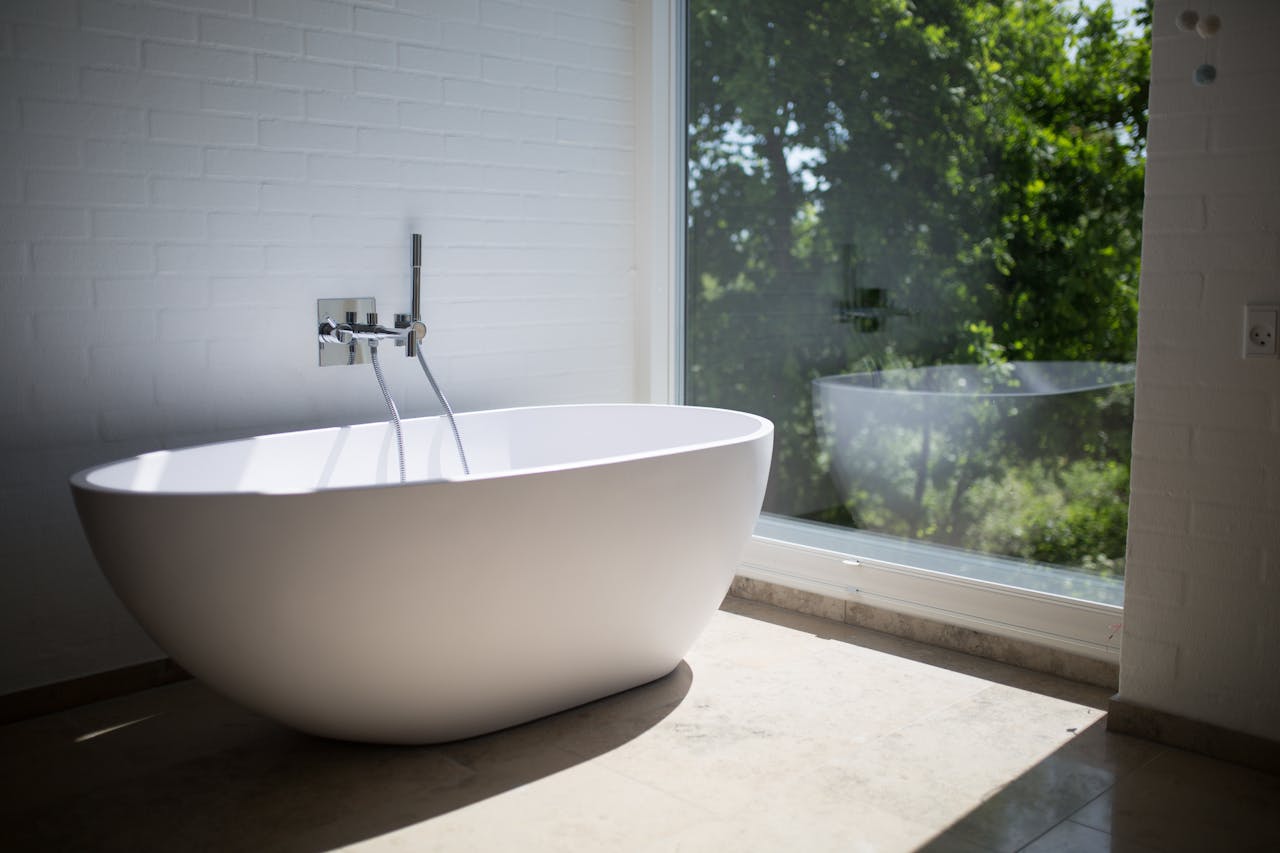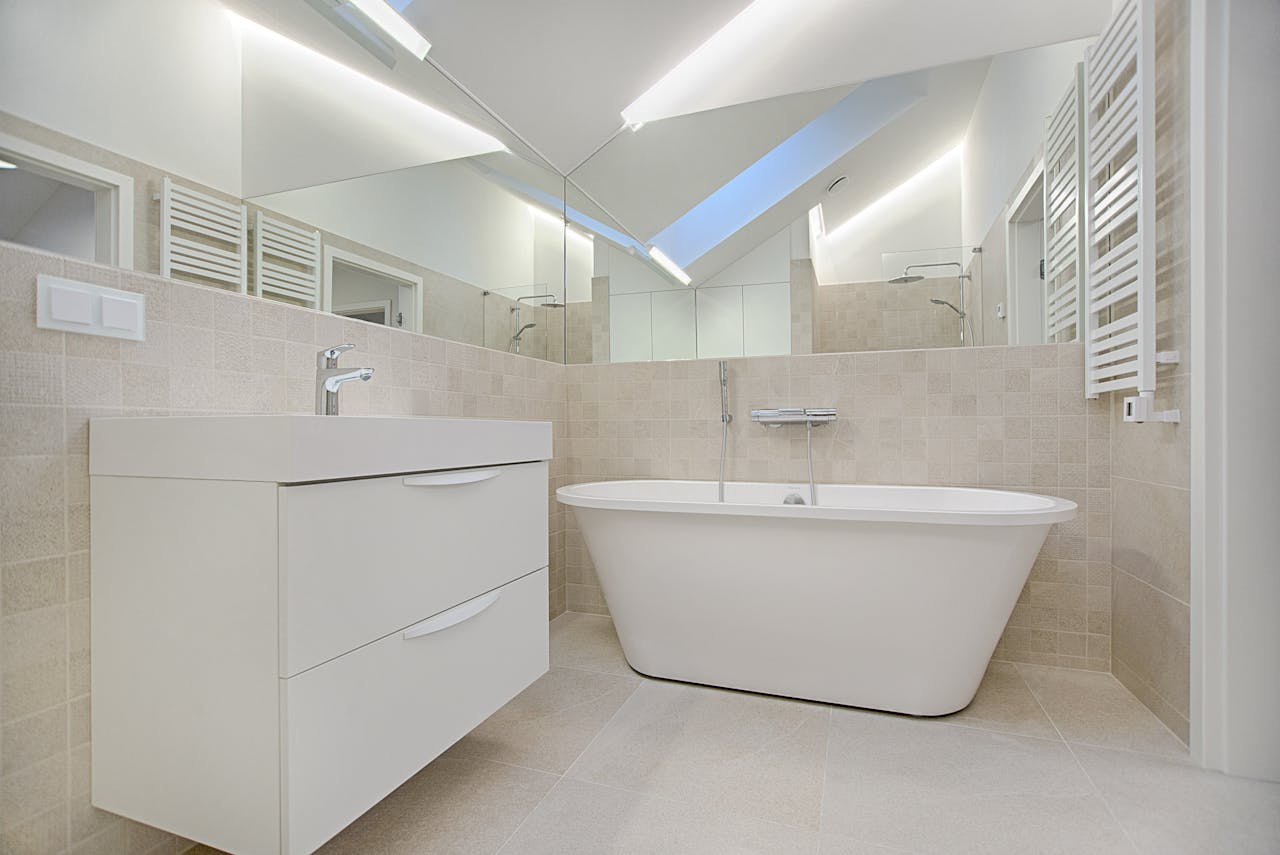
Key Takeaways
- Bathroom remodels in the United States are notorious for going over budget. Unrealistic expectations, unexpected structural problems and project scope creep often play a role in this challenge, so proper planning right from the outset is key.
- Luxury magazine-level layouts and hasty feature replacements start adding dollars fast. Consequently, it’s essential to determine what you need and what you’d like to have in the space before you begin your project.
- Hidden costs such as demo, debris disposal, and temporary bath setup rarely get considered. To account for these surprises, it’s prudent to create a detailed checklist and budget for a contingency fund, at least 10–20% of the overall budget.
- Select budget-friendly materials and keep the same footprint. Don’t change the color of the marble. Understand when to go professional and when to DIY to stretch your budget dollars and maintain quality.
- Getting three contractor bids is very important. Demanding accurate written contracts and requiring direct communication between yourself and the laborers may fix misconceptions and manage costly labor bills!
- Use digital budgeting tools to stop remodeling’s runaway trains first, then remodel smarter. To budget more accurately and make better decisions throughout the project, research material prices online and use visualization software.
Unforeseen water damage, increases in material costs, and alterations to the design once the project is underway all lead to this dilemma. In cities with high demand for contractors like San Francisco, labor costs can double. Plus, if you have ancient pipes or walls, they usually need some additional repair work.
Most people either don’t plan thoroughly enough or don’t account for a little cushion for minor issues. So, unknown expenses arise quickly. To prevent this from happening, have a vision and a plan in place and obtain a defined cost proposal from your contractor. Remember to budget a little more for those unexpected costs!
Understanding the top reasons bathroom remodels go over budget allows homeowners to sidestep unnecessary stress and keep their project on budget. So, what can you do to gain more control? Next, let’s outline some important steps.
Top Reasons Bathroom Costs Skyrocket
Case study #2 Infill remodels, especially in urban markets like San Francisco, tend to be budget busters. This is due to the complexities that come with older homes, the regional cost of labor and changing costs of materials. Despite the best planning possible, a multitude of projects encounter unforeseen issues that result in increased costs.
Knowing the top offenders for budget overruns is an important first step. By learning how to identify these problems beforehand, you can save money! The sections that follow dive into each primary culprit. They provide useful illustrations and background to show readers how to sidestep the big mistakes.
1. Discovering Hidden House Issues
Hidden issues are one of the top reasons bathroom costs skyrocket. Most homes in San Francisco and other cities with similar topography have very old infrastructure. For instance, if your home has old knob and tube wiring, you may have to replace that during a remodel.
This one repair might range from $500 to $5,000, depending on how deep the issue goes. Other usual surprises might be water damage hidden behind walls, rotted floor joists or even outdated plumbing. These all can be painful surprises that are difficult to identify without a complete inspection before the work begins.
Regular inspections, before work starts and after work starts, do much to identify these issues in advance. Allocating a contingency fund—typically 10–20% of the project budget—helps build a cushion for unforeseen issues. Without this safety net, homeowners are often left with difficult decisions or hasty repairs that result in additional expenses down the road.
2. Project Scope Creeping Up
Scope creep occurs when seemingly innocuous additions make their way into the project after the original plan has been set. Once they start seeing the progress on the remodel, a homeowner may want to go with heated floors. Or maybe they go with a luxurious new shower!
Each incremental change can increase the cost since contractors now need to change their bid or order additional materials. Getting a 3 square foot premium on floor tile doesn’t seem like a big deal. Multiply that over a 75-square-foot bathroom and you’re looking at $225!
Knowing every change you make, even the small ones, and how they affect the bottom line is crucial. Making sure the project scope doesn’t expand can save you thousands of dollars in the long run. Preventing scope creep of the project is key!
3. Desiring Premium Material Choices
Choice of materials is a huge factor in bathroom renovation costs. Fancy floor tiles run as high as $3.49 per square foot. Luxury vinyl plank alternatives begin at $0.67 per square foot!
The same is true for faucets and other fixtures— designer brands are frequently much more expensive. Homeowners often get caught up in aesthetics and forget about the bottom line, only to experience sticker shock when the invoices arrive.
Side-by-side comparisons in price and performance can help you find lower-cost options that don’t sacrifice style or durability. If you’re investing in high-quality fixtures, like water-saving toilets or LED lighting, that’s a good investment. In the long run, you’ll reap the benefits of decreased utility costs and less frequent replacement.
It’s all about balancing upfront cost with long-term value.
4. Misjudging True Labor Rates
Perhaps this is where homeowners get the biggest sticker shock, particularly in high-cost areas, such as California’s Bay Area. Depending on local labor markets, skilled trades like plumbers, electricians, or tile setters may demand a higher rate.
A more experienced contractor might charge a higher hourly rate, but they’re usually able to do the job in less time and with better quality. Going with the lowest bid from an inexperienced contractor seems like a good idea, but it already isn’t.
Yet, even with careful planning, a mistake or delay can result in additional costs later in the process. It’s important to familiarize yourself with average rates for the area. Next, solicit detailed, written estimates from multiple contractors to help define your expectations.
When you consider hiring an architect or designer, that’s when you start getting a better picture of true labor costs. This quickly adds up to 15-20% of the entire project!

5. Inadequate Upfront Project Planning
A project with no or unclear plan upfront is a surefire recipe for cost overruns. Without a clear timeline, detailed project scope, and itemized budget, the entire renovation is doomed to confusion and missed steps.
For example, not factoring the cost of lighting fixtures when budgeting can result in surprise expenses. Sinks, recessed lighting, bath fans, GFCI outlets all lead to these surprises that can add up fast. Good planning involves mapping out all the steps needed, keeping the plan flexible enough to adjust it as the project develops.
This is a great practice that minimizes surprises and helps create a clear roadmap for the homeowner and contractor.
6. Contractor Misunderstandings & Changes
Poor communication with your contractors can lead to expensive miscommunications. If agreements can’t be made in writing, arguments over what’s included in the work will be inevitable.
Even if you’re making minor changes, expect to see them noted with explanatory notes and clear pricing. Communicating potential changes upfront and coming to an agreement about how to approach them can go a long way in preventing hiccups.
This is critical when projects get complicated with multiple trades or custom work.
7. Ignoring Permit And Code Rules
Skipping Permit and Code Requirements. Permits and code compliance are often forgotten or discounted. Yet, in cities like San Francisco, building permits, plumbing, electrical, and other fees can add $2,000 to $4,000 to the budget.
There are charges associated with necessary architectural schematics or engineering blueprints. Not only do skipped permits or failed inspections incur fines and delays, but you’ll usually need to redo work.
Researching local requirements and budgeting for all associated fees before getting to work will help you avoid costly surprises down the road.
8. Unexpected Material Price Hikes
Bathroom material prices are in constant flux. Global supply shortages, increased demand, or tariffs can cause prices to rise between when an item is specified and when it is ordered.
Waiting for custom or out-of-stock items, like a tub shipped from another stat, can delay the project and add storage or rescheduling costs. Getting materials secured and ordered as early as you can manage goes a long way to locking in costs and preventing delays.
9. The “While We’re At It” Trap
It’s easy to want to squeeze in extra work when the team comes to town. Conquering a closet or renovating nearby areas may feel like a smart move, but this contributes to the cost.
Avoiding bathroom cost pitfalls & managing expectations Maintaining a sharp focus on the key bathroom remodel going in prevents the wish list from taking over this important project. By taking this approach, you can avoid scope creep and ensure the primary project stays on budget.
Smart Ways To Control Your Budget
Bathroom remodels notoriously go over budget because of scope creep and unforeseen complications. On top of this, costs can balloon as decisions on the project change. Managing a remodel in San Francisco, or any urban market, adds layers of complexity. Labor is pricey, permits take time, and every square foot counts. With a smart strategy, it can be done to maintain budget neutrality. With a little smart planning, you can sidestep the common traps. With the proper tools, it will be easy to stay focused and on course throughout the entire process of remodeling your bathroom.
Create A Detailed, Realistic Plan
A detailed plan is the foundation of any successful remodel. Create a workup with every single thing that needs to be done, every material they need, every piece of labor that’s involved. This plan should itemize the whole scope—demo, plumbing, tile, fixtures, electrical, finishes, etc. Plan to fail without it.
Research is the lifeblood of advocacy. Don’t tack on markup at the end—price every part, from tile to faucets, individually. Remember to include tax, delivery charges, and things like grout and caulking! Choose a timeline that takes into consideration actual lead times for products and labor.
In the Bay Area, certain fixtures or tiles can take weeks to get delivered. Advance planning will keep you on schedule and prevent expensive last-minute modifications! Revisit your plan frequently, as work is done and continually. If you have to exchange a product or change the schedule of a crew, make that modification immediately.
Revise your budget and schedule estimates to be proactive, not reactive!
Secure Multiple Contractor Bids
Getting multiple bids isn’t just about getting the cheapest quote. It’s about getting a better view of all possible approaches and finding costly surprises or cost-saving shortcuts that may have been taken. Request that each contractor provide an itemized bid that explains all of their costs.
In a competitive market, like San Francisco, we are talking about pricing being different by thousands, even for the same scope of work. Look at references, check out licenses, and tour finished projects when you can. Cost is important, but experience and reputation go a long way—sometimes, hiring a cheap contractor is more costly than hiring a reliable one right away.
Leverage the bids to negotiate. Occasionally, one of the contractors will give you a better price or include an extra upgrade when they realize you’re looking at other bids, too. Timing is important—contractors might have more competitive rates if you schedule work in their off-season, like late winter or early fall.
Always Include A Contingency Fund
Unfortunately, no matter how thorough you are, older homes frequently come with surprises lurking within their walls. You may find extensive water damage, unsafe wiring, or plumbing that isn’t up to code. Always include a contingency fund.
Plan and set aside 10–20% of your budget to address these unexpected concerns. This additional cushion can be the difference between a project getting stuck and one that proceeds without a hitch. Discuss this fund early on with everyone—your contractor, your designer, and anyone who co-owns the building.
That’s so no one is surprised when things start to change in terms of cost. When work starts, review the contingency fund as work unfolds. If you run into a roadblock at the outset, pivot your strategy immediately. You’ll probably have to cut costs in other areas to stay within your budget.
Prioritize Your Must-Have Features
Not every feature needs to be included. Start by identifying what’s most important to you, such as a walk-in shower, increased storage, or improved lighting. This outline is useful when the budget starts to pinch.
If you know radiant floor heat or a custom vanity is out of your budget, do something now! Remove or replace lower-priority elements before anything else. Establishing these priorities early on leads to less scrambling at the end and expensive rework.
In addition, it helps prevent scope creep by making sure the project remains centered on what’s really needed—not just impulse improvements.
Keep The Current Layout
Once you start changing the layout—removing or moving a toilet, sink, or tub—costs can increase dramatically. Plumbing and electrical work is expensive in antiquated buildings. In San Francisco, permits and inspections make those costs even worse!
Retaining the existing footprint takes less time and money. If you’re looking for an updated appearance, consider starting with simple adjustments! Rearranging cabinets or installing open shelving to create more display area can make the space feel fresh with little construction.Evenn minor exchanges—opting for corner shelves over recessed niches—can save costs and time.
Choose Cost-Effective Alternatives
You don’t have to have luxury materials to create a luxurious feeling bathroom. Smart alternatives such as porcelain tile can be made to look almost indistinguishable from marble—all while costing a fraction of the price.
In addition, timeless and sturdy choices tend to age more gracefully! Compare brands on fixtures and hardware—brands have budget lines that hold up well to brands’ higher-end lines. Purchasing materials well in advance—ideally when they’re on sale or before a scheduled price increase—saves significant expenses and avoids costly project delays.
Be sure to consider the long-term durability of your budget-friendly selections, so you don’t swap short-term savings for long-term repairs.
Know When To DIY VS. Pro
DIY work can indeed save thousands of dollars on a project, but it’s not always the smartest decision. Projects such as painting or installing basic shelving are within everyone’s reach. However, plumbing, electrical, and waterproofing require professional skills.
Blunders in these areas get costly in a hurry. If you are skilled and equipped for the work, mini jobs you can tackle yourself bring significant value to your project. Nevertheless, prepare for the unexpected.
Once demolition starts, you may often discover damage or other problems that require the hand of a professional. Understanding where your expertise ends and knowing when to ask for assistance will result in less expensive rework later and a higher quality product.

Finding And Working With Contractors
Selecting and working with the right contractor usually determines how successful a bathroom remodel will be at staying under budget. This is something many homeowners, particularly those inexperienced with large renovations, quickly discover—that project costs have a way of skyrocketing well beyond what was initially envisioned.
A good strategy for selecting a contractor and maintaining an engaged, collaborative working relationship goes a long way in preventing this not-so-rare trap.
Thoroughly Vet Potential Hires
It all begins with research. Get recommendations from friends or neighbors in San Francisco and read reviews on reputable local websites. It’s just good sense to verify that every contractor has the proper licenses and insurance.
Here, you’re getting protection against any potential legal or financial liability if something bad happens. Interview multiple contractors before deciding. Conduct these interviews to evaluate whether they listen closely, reason effectively, and maintain professionalism.
More seasoned homeowners know better, but it’s an easy step to overlook. They’ve found out the hard way that leaving it out often results in more expensive corrections later on.
Insist On A Clear Contract
Having a clear written contract, specific to that job, signed by both partie, –is your best defense. Insist on a Clear Contract. Ensure the contract clearly outlines your payment schedule, completion da,te and project scope.
These specifics protect you from “scope creep,” when alterations accumulate and increase expenses. Review the contract in detail, line by line, as tedious as it may seem. Fighting over confusion later is more difficult than clearing it up now, so don’t risk it.
Establish Open Communication Channels
Never stop communicating. Establish a rhythm of weekly meetings or calls to check in on the work, pose questions, and raise red flags at Earnoticeces. Contractors will be able to identify ways to save money or where you may be adding to the final bill.
Honest, constructive feedback from both sides creates a collaborative environment that fosters trust and keeps everyone aligned with the overall objective.
Understand Change Order Processes
Understand that changes are a normal part of a remodel, but they increase costs. Require your contractor to detail how each change will impact your budget.
Put every change in writing and get both parties to agree and sign. Getting on the same page with change orders can prevent small tweaks from becoming major surprises.
Using Tech For Smarter Budgeting
Homeowners in San Francisco and other tech-savvy cities have more digital options than ever to keep bathroom remodels on budget. Smart budgeting using today’s technology offers real assistance at every step of the way—from planning through purchase. Digital tools make it easier to plan, track, and manage costs. They equip citizens to advocate for smarter, better design and use of materials.
Digital Budgeting Tools Help
Utilizing budgeting applications such as Mint or YNAB allows users to monitor remodel costs in real time. These applications make it easy to visualize where their money is being spent, automatically flag overages, and help users identify areas where they can find savings.
Spreadsheets—such as those used in Excel or Google Sheets—provide a straightforward breakdown of project costs by labor, materials, permits and contingencies. This creates a much higher level of transparency to every aspect of the job. Automatic syncing ensures every figure is up to date.
This helps homeowners identify areas of concern sooner and make corrections before expenses become excessive. Bay One residents learn more about these new mobile tools and bill reminders. These resources keep them on track to avoid costly late fees and develop better financial habits.
Visualize Designs Before Committing
3D design software, like SketchUp or RoomSketcher, allows prospective clients to build a 3D model of their future bath. By creating and experimenting with various layouts, styles, and finishes digitally, they get a better sense of what will look best before making any purchases.
This prevents costly adjustments during the project. Homeowners will be able to distribute these digital plans with contractors. This keeps everyone focused on the same goals and prevents expensive missteps.
Compare Material Prices Online
Specifically, online shopping for tiles, fixtures, and hardware enables everyone to do price comparisons across various suppliers, both locally in the Bay Area and beyond. This allows homeowners to check real-time costs, availability, and quality. Being aware of price fluctuations helps make better procurement decisions, which is critical in a cost-intensive environment like San Francisco. At Mares & Dow Construction & Skylights Inc., we assist clients in navigating these choices to ensure they get the best value for their remodel.
My View: Splurge Here, Save There
The key to staying on budget during a bathroom remodel is learning when to splurge and when to save. In San Francisco, where home values are sky high and pre-1979 homes are the norm, these calls are especially consequential.
First, consider performance versus aesthetics. Repair leaks, replace plumbing infrastructure, and get the fundamentals squared away before choosing tile or lighting. This ensures you don’t end up busting the budget on cosmetics while larger issues remain.
Invest In Durable Fixtures
Investing in durable fixtures is a smart investment. Avoid low-cost faucets or showerheads, which break down quickly, and seek out manufacturers with durable replacement parts.
A moderately priced faucet—say under $300—usually does the job quite adequately and still can fit the décor of the room. For kitchen sinks or bathroom tubs, solid surfaces resist chips and pits much better in the hustle and bustle of our city homes. That translates to less money spent on repairs later on.
Smart Tile Choices Save Big
Tiles can devour your budget dollars if you allow them to. Porcelain or ceramic tiles are super sharp, very durable, and are typically a fraction of the cost of stone.
Consider purchasing in bulk to save even more—this is particularly true for larger bathrooms. To achieve a high-end aesthetic without the high-end price tag, consider pairing more expensive accent tiles with affordable staples.
Don’t Skimp On Good Lighting
Good lighting makes a world of difference. Not only does a brighter bathroom look more spacious, it improves the daily experience as well.
Since LED fixtures consume less wattage, this results in savings on monthly bills as well. Layered lighting—such as pairing ceiling lights with vanity sconces—combines everyday use and design.
Focus On Long-Term Value
Go beyond your immediate worldview. High quality updates such as walk-in showers or double vanities add to resale value immensely.
Not only do prefab cabinets cost a fraction of their custom counterparts, but they can be every bit as sleek and polished. Always add a 25% cushion for surprises—restored antique homes often have unexpected issues.
Conclusion
Old pipes are prone to breakage. Potential problem #2 — Tiles cracking. Shortages of fixtures occur. The little things, such as permit fees or trash haul-away, sneak up on you and begin to devour your money. San Francisco labor rates certainly aren’t doing her any favors on that front. Having a clearly defined plan goes a long way. Request written estimates of overall costs. Request detailed bids from all contractors. Utilize budgeting apps to monitor your weekly expenses. The best contractors are direct communicators who raise concerns at the first sign of a problem. Determine areas to invest—like a quality shower valve—and areas to cut costs—such as choosing mid-range tile. Smart choices made before the remodel begins save money, time, and stress. To avoid budget blowouts, communicate with your team, get a full understanding of costs, and keep track of what you’re spending. Do you have bathroom remodel horror stories or advice to help others stay on budget? Let’s continue to learn from one another.
Frequently Asked Questions
1. Why Do Most Bathroom Remodels Go Over Budget?
There are always surprise problems that arise, such as water damage, old plumbing, and mold. A lot of homeowners are guilty of underestimating labor and material costs, or making additions to the plans halfway through.
2. What Are The Biggest Hidden Costs In A Bathroom Remodel?
Repairing subfloors,movingg plumbing, upgrading electrical wiring Permit fees. These are some of the most expensive hidden costs associated with any bathroom remodel. These design choices can cost you hundreds or even thousands more than you expected.
3. How Can I Avoid Overspending On My Bathroom Remodel?
Determine a realistic budget, add a 15–20% cushion for unexpected issues, and follow your smart plan. Get multiple bids, don’t make changes at the 11th hour, and monitor your spending like a hawk.
4. Is It Cheaper To Remodel A Bathroom In San Francisco?
Bathroom remodels during inflationary times are even more likely to go over budget due to high labor rates, expensive permits, and pricier materials. It’s important to always do your due diligence on local rates and plan accordingly.
5. What Should I Look For In A Bathroom Remodeling Contractor?
Look for a current California contractor’s license, insurance, and positive references. Request references and design-build detailed estimates before making a hire.
6. How Can Technology Help Me Stay On Budget?
Utilize budgeting apps, project management tools, and online cost calculators. These allow owners to monitor spending, stay organized, and prevent budget-busting surprises.
7. Where Should I Splurge And Where Should I Save In A Bathroom Remodel?
Save on your splurge. As with any remodel, quality fixtures should be your splurge item. Splurge on your big-ticket items Save on decorative finishes Save on decorative finishes and accessories. Keep your remodeling budget centered on upgrades that will stand the test of time and are necessary.
Your Dream Bathroom Starts With Mares & Dow Construction – Let’s Build A Beautiful Space Together
Thinking about a bathroom remodel in Concord, Walnut Creek, Pleasant Hill, or Lafayette? Whether you’re envisioning a luxurious spa-like retreat or a smart, space-saving update, choosing the right contractor is the most important step in turning your vision into reality.
With over 40 years of proven experience, the team at Mares & Dow Construction & Skylights is trusted throughout Contra Costa County for expert craftsmanship, transparent pricing, and outstanding customer service. We specialize in:
- Bathroom Remodeling – Upgrade your outdated bathroom into a stylish, functional, and energy-efficient space. From elegant tilework and modern fixtures to walk-in showers and custom vanities, we handle every detail with precision.
- Decks and Outdoor Living Spaces – Extend your home’s living space with beautifully designed decks, patios, and pergolas built to last.
- Foundation Repairs and Waterproofing – Protect your home from moisture and structural damage with our reliable repair and waterproofing services.
- Custom Skylight Installations – Brighten your bathroom naturally with premium skylight solutions installed by a certified VELUX 5-Star Skylight Specialist.
- General Contracting Services – From bathroom renovations to larger home improvement projects, we manage every aspect with the highest standards in the industry.
Proudly serving Alamo, Danville, Orinda, Martinez, San Ramon, and the surrounding areas, Mares & Dow Construction & Skylights is committed to delivering exceptional results. Whether you’re a homeowner upgrading your primary bathroom or an investor modernizing a property, we ensure your remodel is completed on time, within budget, and with superior quality.
Don’t trust your bathroom remodel to just anyone. Contact Mares & Dow Construction & Skylights today for a free, no-obligation consultation, and let’s turn your bathroom into a space you love.
Disclaimer
The materials available on this website are for informational and educational purposes only and are not intended to provide construction, legal, or professional advice. You should consult with a qualified general contractor or industry professional for advice concerning any specific construction project, remodeling plan, or structural concern. Do not act or refrain from acting based on any content included on this site without seeking appropriate professional guidance. The information presented on this website may not reflect the most current building codes, regulations, or industry best practices. No action should be taken in reliance on the information on this website. We disclaim all liability for actions taken or not taken based on any or all of the contents of this site to the fullest extent permitted by law.





 based on
based on 

